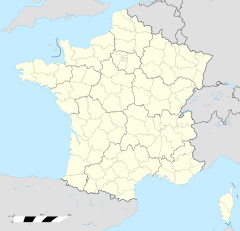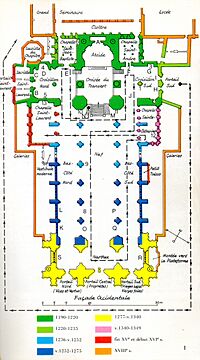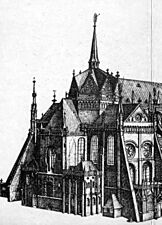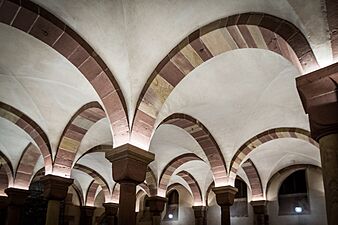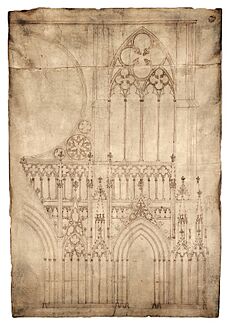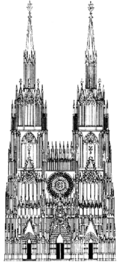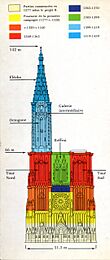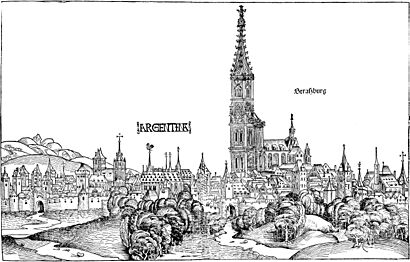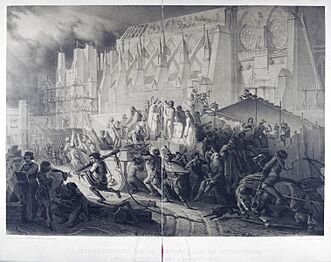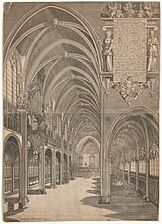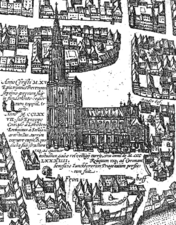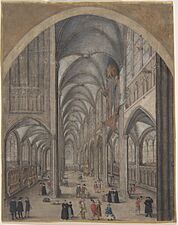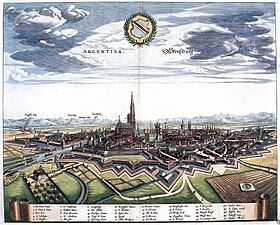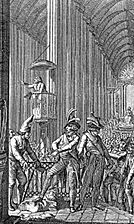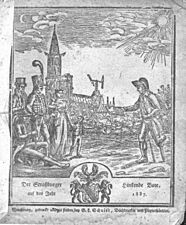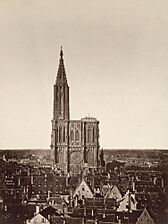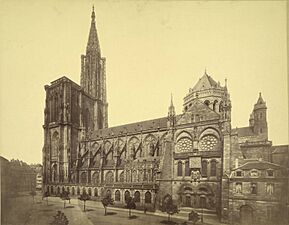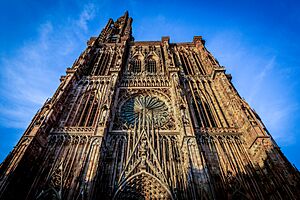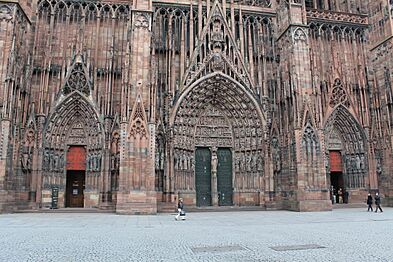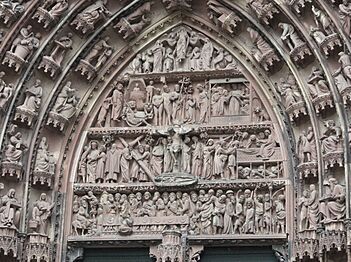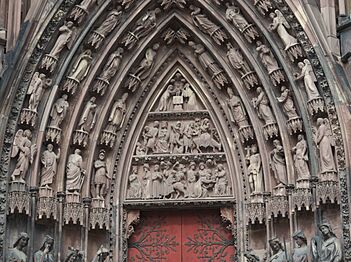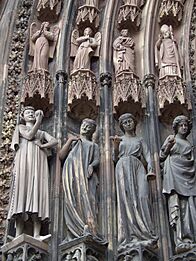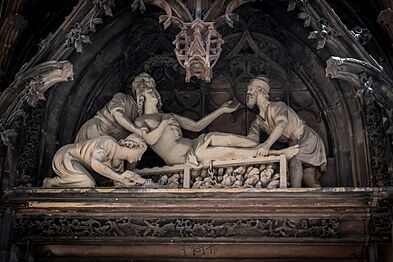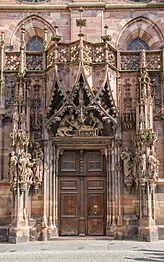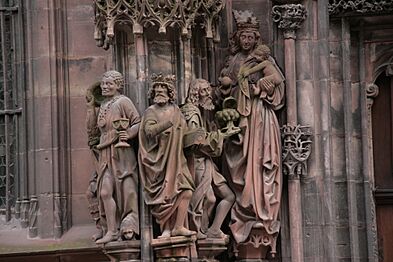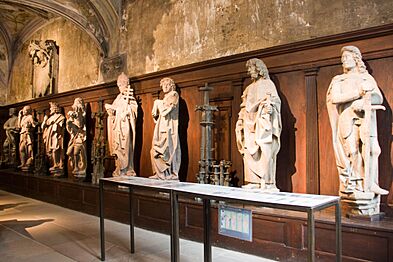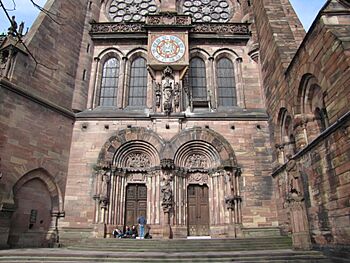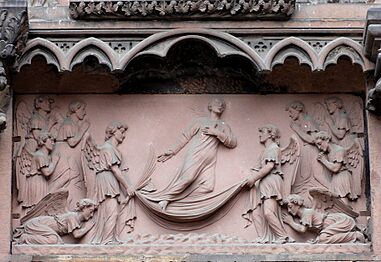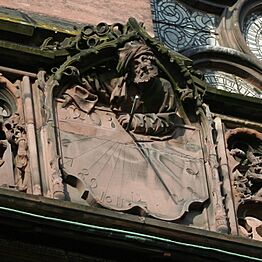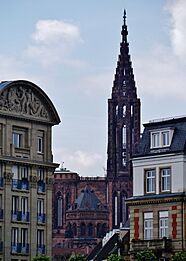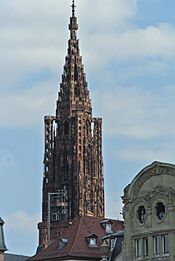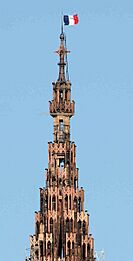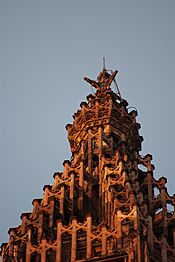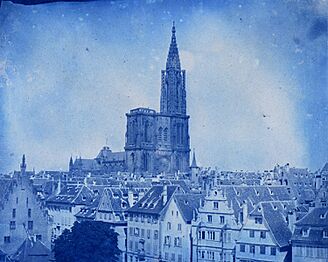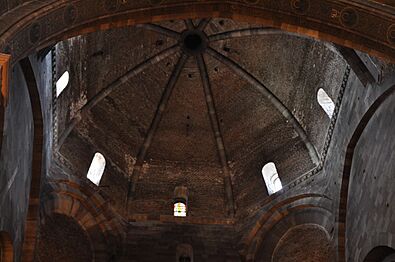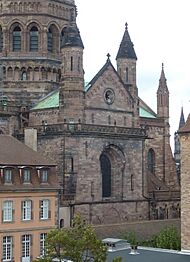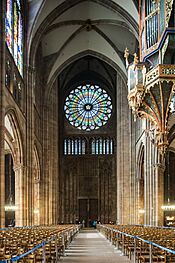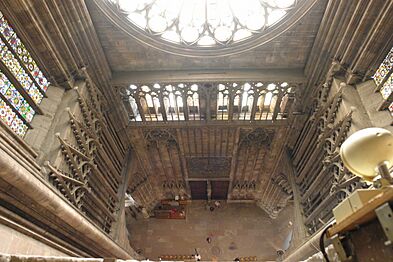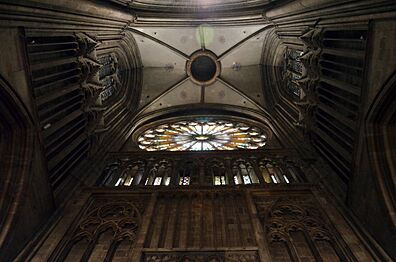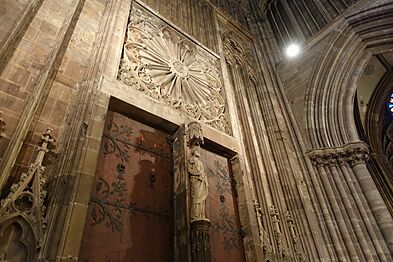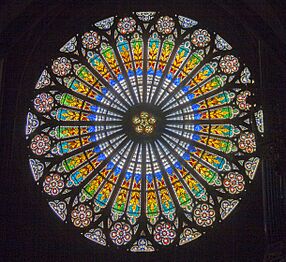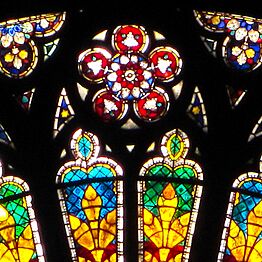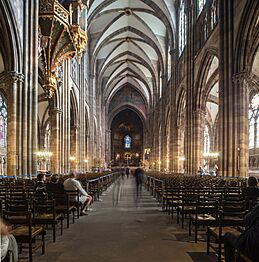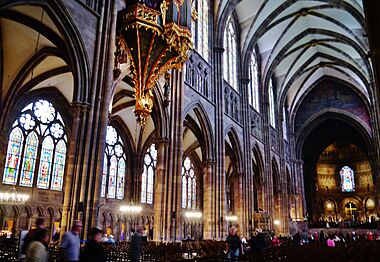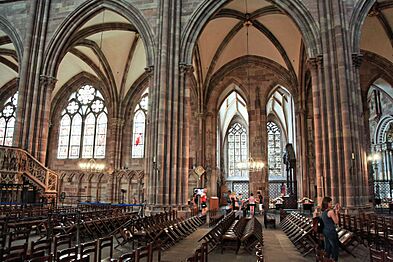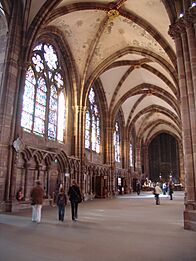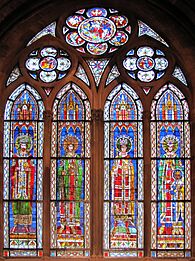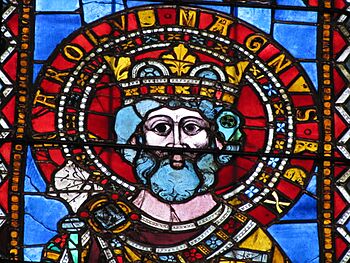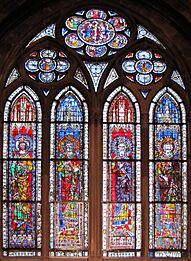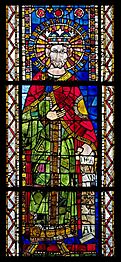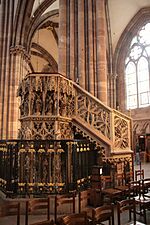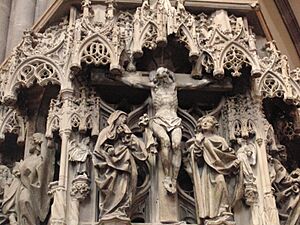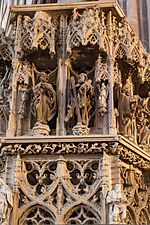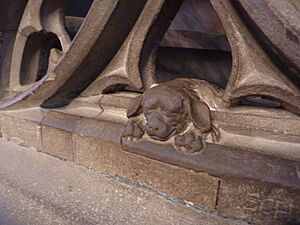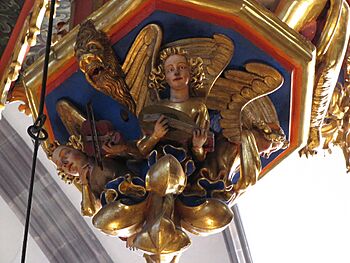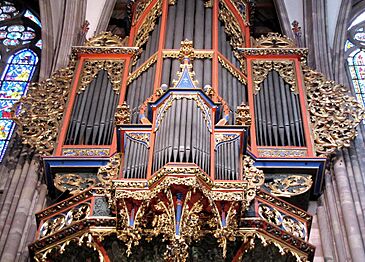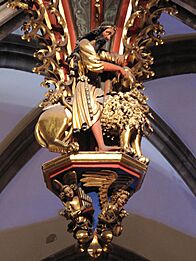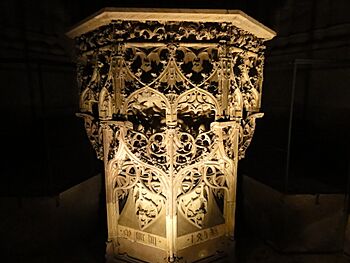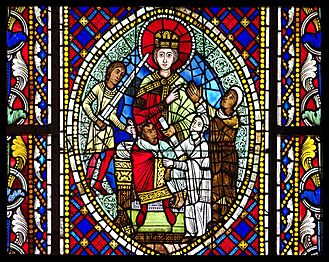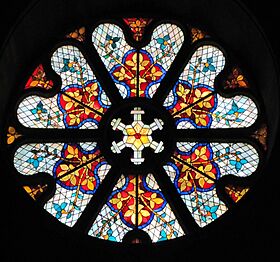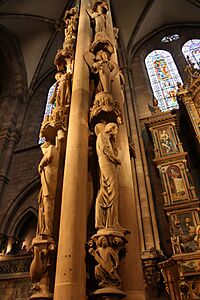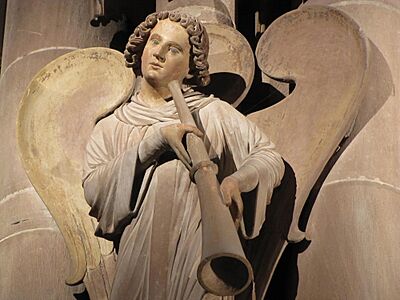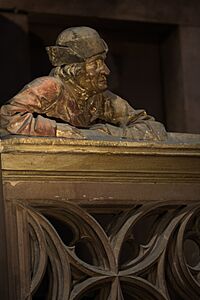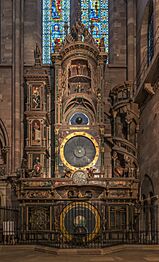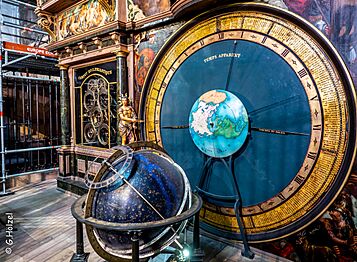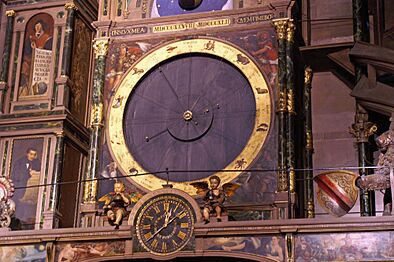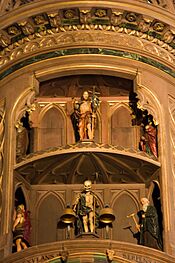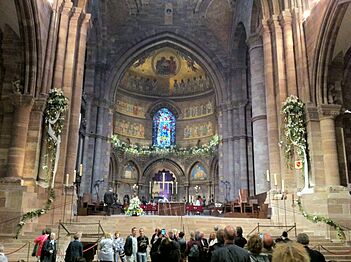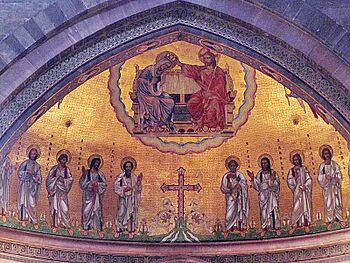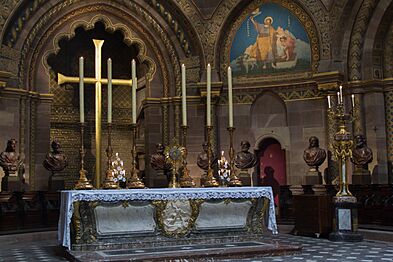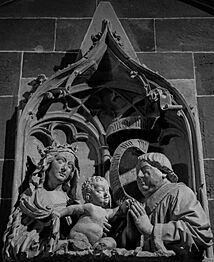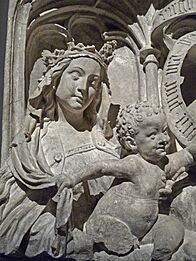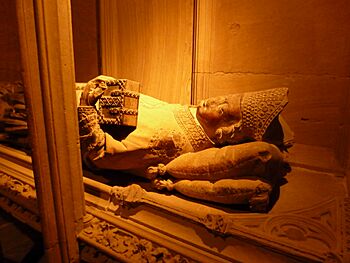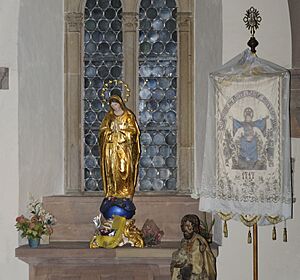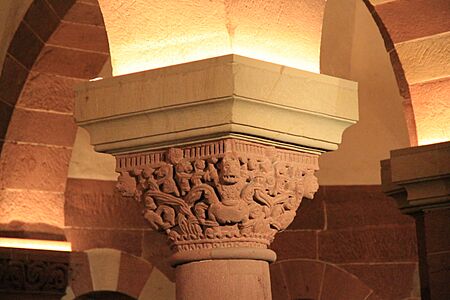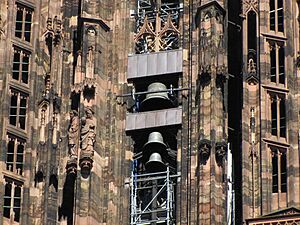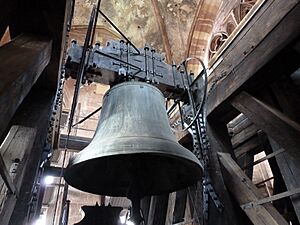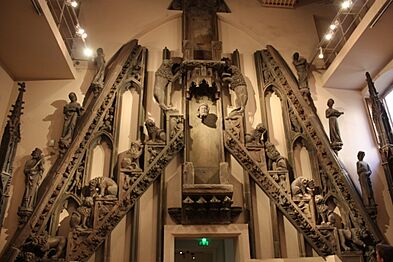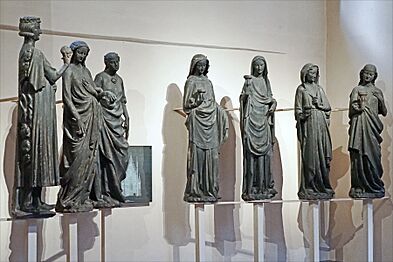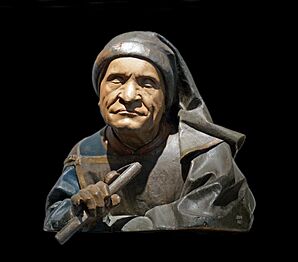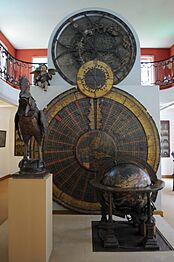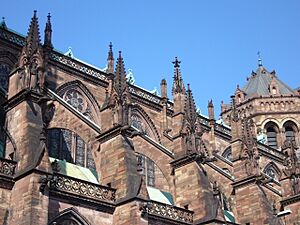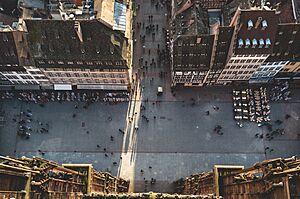Strasbourg Cathedral facts for kids
Quick facts for kids Strasbourg CathedralCathédrale Notre-Dame de Strasbourg |
|
|---|---|
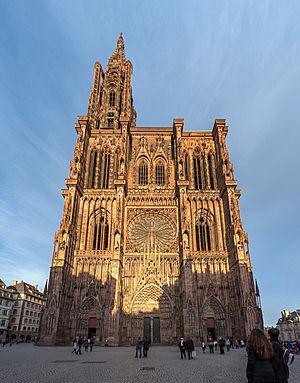 |
|
| Religion | |
| Affiliation | Roman Catholic |
| District | Archdiocese of Strasbourg |
| Rite | Roman |
| Ecclesiastical or organizational status | Cathedral |
| Leadership | Archbishop Pascal Michel Ghislain Delannoy |
| Status | Active |
| Location | |
| Location | Strasbourg, France |
| Architecture | |
| Architectural type | Church |
| Architectural style | Romanesque, Gothic |
| Groundbreaking | 1015 |
| Completed | 1439 |
| Specifications | |
| Direction of façade | Southwest |
| Length | 112 metres (367 ft) |
| Height (max) | 32.6 metres (107 ft) (Nave) |
| Dome(s) | 1 |
| Dome height (outer) | 58 m (190 ft) |
| Spire(s) | 1 |
| Spire height | 142 metres (466 ft) |
| Materials | Sandstone |
|
Monument historique
|
|
| Official name: Cathédrale Notre-Dame de Strasbourg | |
| 1862 | |
| PA00085015 | |
| Denomination | Église |
The Strasbourg Cathedral, also known as the Cathedral of Our Lady of Strasbourg, is a famous Catholic church in Strasbourg, Alsace, France. It's a mix of old Romanesque architecture and beautiful Gothic architecture, especially the "Rayonnant" style.
Construction started way back in 1015 and was mostly finished in 1439. For 227 years, from 1647 to 1874, it was the tallest building in the world! Today, it's still one of the tallest churches and the tallest building made entirely in the Middle Ages.
The cathedral stands at 142 metres (466 feet) tall. Famous writers like Victor Hugo and Johann Wolfgang von Goethe admired it greatly. Its unique reddish-brown color comes from the sandstone used, which was brought from the nearby Vosges Mountains. You can see the cathedral from far away, even from the Black Forest across the Rhine river.
Since 1224, a group called the Fondation de l'Œuvre Notre-Dame has looked after the cathedral. They even have a museum, the Musée de l'Œuvre Notre-Dame, which shows original art from the cathedral. In 1988, the cathedral and the historic city center (called the "Grande Île") became a UNESCO World Heritage List site because of its amazing Gothic design.
Contents
History of the Cathedral
The story of Strasbourg Cathedral is well known thanks to old records. Digs around the cathedral have also helped us learn about its past.
Early Buildings on the Site
Long ago, around 12 BC, a Roman town called Argentoratum was here. It was a busy trading center. Christianity came to the area in 313. The first church on this spot was built by Bishop Saint Arbogast around 550–575. Later, around 778, a Carolingian church was built, but no parts of it remain today.
The Romanesque Cathedral
In 1015, Bishop Werner started building a new, very large cathedral. It was almost as big as the one we see today. This church had a wooden roof, which unfortunately caught fire many times (in 1136, 1140, 1150, and 1176). Each time, it was repaired, but it kept its strong, thick Romanesque walls and small windows.
The Romanesque-Gothic Cathedral
Around 1181, Bishop Heinrich I wanted an even more beautiful cathedral. So, they started rebuilding, adding new Gothic architecture styles from northern France. Between 1200 and 1228, they replaced the old Romanesque vaults with stronger Gothic ones. This allowed for thinner walls and bigger windows.
The Gothic style also appeared in the statues, like the famous Pillar of the Angels. From 1240 to 1274, the main part of the church, called the nave, was rebuilt in Gothic style. It was made much taller, reaching 27 meters, with beautiful stained glass windows.
Rayonnant Additions (1277–1439)
The next big project was rebuilding the front of the cathedral in Gothic style. Work began on May 25, 1277. The new design was inspired by French cathedrals. It featured a tall, wide front with many decorative elements. The plan was to have two tall spires, but only one was ever built.
Architects like Erwin von Steinbach and his family made big contributions. Later, Ulrich Ensingen and Johannes Hültz finished the single, tall tower and spire. The entire construction of the cathedral was completed in 1439.
The north tower was the world's tallest building from 1647 until 1874. Today, its unique single tower makes the cathedral a famous landmark of Alsace. From the observation deck, you can see for 30 kilometers!
Later History
In the late Middle Ages, Strasbourg became a Free Imperial City. In 1524, the city council made the cathedral a Protestant church. Some parts of the building were damaged during this time.
In 1681, France took over Strasbourg. The cathedral was then returned to the Catholic Church. Its inside was changed to fit Catholic worship. For example, the old choir screen was removed in 1682.
The French Revolution and 19th Century
-
Notre Dame of Strasbourg turned into a Temple of Reason during the French Revolution
-
Strasbourg cathedral in 1837 with an optical telegraph
During the French Revolution (starting in 1789), church property was taken by the state. Many statues on the cathedral were damaged or destroyed. Luckily, some were saved by being covered up. In 1794, people even planned to tear down the spire! But citizens saved it by putting a giant tin hat on top.
Seven church bells were melted down to make cannons. In November 1793, the cathedral was called a "Temple of Reason." It wasn't returned to the church until 1801. The French state still owns it today.
Major repairs and changes happened in the 19th century. The roof was set on fire during the Franco-Prussian War in 1870–71. After the war, Alsace became part of Germany until 1918.
20th and 21st Century
In the early 1900s, engineers worked to strengthen the cathedral's foundations. This big project finished in 1926. In 1918, Strasbourg became part of France again.
During World War II, the cathedral was very important to both sides. Its beautiful stained glass windows were removed and hidden in a salt mine for safety. They were returned after the war. The cathedral was hit by bombs in 1944, but repairs were completed by the early 1990s.
In 1988, Pope John Paul II visited the cathedral. In 2000, a plan to bomb the nearby Christmas market was stopped by police. Restoration work on the tower was finished in 2006.
Outside the Cathedral
The West Front
The west front is the main entrance of the cathedral. It was built between 1275 and 1399. It has three levels: the main doors, a large rose window, and a top level with a railing. The rose window is 14 meters wide and was finished in 1345. The front is covered in delicate, lacelike stone decorations, making it look very tall and grand. Its dark red stone gives it a special look.
West Portals
The cathedral has three main doors, called portals. Each one has a special theme. The left portal shows the birth of Christ. The central portal tells the story of Christ's life and death. The right portal shows the Last Judgement. The statues on these portals are very detailed and show many emotions.
Portal of Saint Lawrence (North Transept)
The Portal of Saint Lawrence was added to the north side of the church between 1495 and 1505. It has a very fancy, late Gothic style. Most of the statues you see there today are copies; the originals are in the Musée de l'Œuvre Notre-Dame.
Portal of the Virgin (South Transept)
The south portal, or Portal of the Virgin, dates back to the 1220s. It shows the Virgin Mary dying and being crowned by Christ. This portal also has a colorful clock with zodiac signs and an old sundial from 1493. Like other portals, many original statues are now in the museum.
Octagon Bell Tower and Spire
The cathedral was meant to have two towers on its front, but only the north one was built. This eight-sided tower was started in 1399 and finished with its spire in 1439. The tower is very tall and slender. It has many openings that let light in and show the bells. The spire above is made of eight detailed sections, with a stairway inside leading to the top.
Crossing Dome and Chevet
The dome sits where the main parts of the church meet. It has eight sides and was built around 1330. The current, taller dome was designed in the 1800s after the original was damaged.
The chevet, at the back of the cathedral, has parts from the very old Romanesque church. It's the least decorated side and looks a bit like a medieval fortress. Two small chapels, for Saint Andrew and Saint John the Baptist, are attached to this end.
Inside the Cathedral
Narthex
The narthex is the entrance area just inside the main doors. It has two huge pillars that support the tower above. The most striking feature is the large rose window, added between 1320 and 1340. It has yellow glass rays like the sun, surrounded by green and blue patterns.
Stained Glass of Narthex
The windows in the narthex show scenes from the Book of Genesis, like the creation of Adam and Eve and Noah's ark. These windows are from about 1345.
The nave is the main part of the church where people sit. It is 61.5 metres (202 ft) long and 32.616 metres (107.01 ft) tall. Its reddish-brown color comes from the same sandstone as the outside. The nave has two rows of huge pillars, each made of many smaller columns. These columns reach up to support the high ceilings. The walls have three levels of windows, filling the space with light.
-
The head of Charlemagne
On the north side of the nave, you'll find some of the oldest stained glass in the cathedral, from around 1180. These "Emperor Windows" show nine Emperors of the Holy Roman Empire. Each emperor holds a scepter and an orb, symbols of their power. Some windows are a mix of glass from different times. The small round windows above the emperors show scenes from the life of Christ.
The upper windows of the nave, from 1250 to 1275, show 84 saints. On the south side, some windows show female saints, while others show soldiers, popes, and bishops.
Pulpit
The pulpit, where preachers speak, was carved in 1485. It's very fancy, covered with small columns, arches, and statues of Christ, the Virgin Mary, and saints. There's even a small statue of a dog on the stairs, mourning his master, a famous preacher named Johann Geiler von Kaysersberg.
The Grand Organ
The grand organ is high up on the north wall of the nave. It has been rebuilt many times since 1260. The current organ was largely built by André Silbermann in 1716. It's beautifully decorated with sculptures, including a moving figure of Samson opening a lion's jaws! The organ has 47 different sounds and many pipes.
The cathedral also has two smaller organs: one in the choir and one in the crypt.
North Transept
The transept and the apse are a bit higher than the nave because they are built over the old Romanesque crypt. The north transept has old Gothic vaults and windows. The windows show scenes like the "Judgement of Solomon" and figures like the Virgin Mary and Saint John. The north transept also holds two baptismal fonts from 1453.
South Transept
The south transept is home to the famous Pillar of Angels. This huge pillar supports the ceiling and is covered with statues. It shows scenes from Christ's life and the Last Judgement. There are angels with trumpets and statues of the four Evangelists. The rose windows in this area were made between 1230 and 1235.
Astronomical Clock
The astronomical clock, located in the south transept, is one of the cathedral's most amazing features. The first clock was here from 1352 to 1500. The current clock was built between 1837 and 1842.
This clock is 18 meters tall and shows much more than just the time! It tells the solar time, the day of the week (each with a god from mythology), the month, the year, the zodiac sign, the moon's phase, and the positions of several planets. It even has a celestial globe that shows 1,022 stars!
At 12:30 PM every day (except Sundays), mechanical figures come to life. Angels ring bells and turn an hourglass. Figures representing the ages of life (from child to old man) parade in front of Death. Finally, the Apostles pass in front of Christ.
Apse
The apse is the rounded area behind the main altar. It has a mix of Romanesque and Gothic styles, with 19th-century paintings. The main altar is a recreation of an older one. The stained glass window in the center of the apse, showing the Virgin of Alsace, was a gift from the Council of Europe in 1956.
The Chapel of Saint Catherine
The Chapel of St. Catherine is in the southwest part of the cathedral. It was built between 1830 and 1839. Inside, you can see a sculpture of the Mother Mary holding Christ. There's also a modern stained glass window called "the stained glass window of a hundred faces." A special item here is a toe bone of Alphonse-Marie Eppinger, placed in the chapel in 2016.
Chapel of Saint John the Baptist
The Chapel of Saint John the Baptist is to the left of the apse. It's one of the oldest parts of the cathedral, built around 1170 and rebuilt in Gothic style in 1230. It holds the tombs of important bishops from the 1300s and 1400s.
Chapel of Saint Andrew
The Chapel of Saint Andrew is on the southeast side, to the right of the apse. It was built shortly after 1150. This chapel is dedicated to the memory of six canons (church officials) buried there. It also has a sculpture of the Virgin Mary from 1521.
Crypt
The cathedral has two Romanesque crypts, which are the oldest parts of the building. The newer one is from about 1150, and the older one, under the apse, is from around 1110–1120. They have rounded stone ceilings supported by huge pillars. Some pillars even have carved monsters and lions!
Bells
In 1519, Strasbourg Cathedral ordered a huge bell, said to be the largest in Europe. It weighed 20 tons! But it cracked soon after. An older bell, the "Totenglock" (Death bell), became the largest. It weighs 7.5 tons and was made in 1447. It's still there today.
During the French Revolution, nine bells were melted down for cannons. But the "Totenglock" and another bell, the "Zehrnerglock," were saved. More recently, six new bells were made in Germany between 1974 and 1976.
The four bells in the octagon tower ring on the hour. Other bells ring for weekly masses, baptisms, weddings, and funerals.
Tapestries
The cathedral has 14 tapestries that show the life of the Virgin Mary. They were made in Paris between 1638 and 1657. The cathedral bought them in 1739. These tapestries are usually hung in the nave during Advent.
Cathedral Art in Strasbourg Museums
The Musée de l'Œuvre Notre-Dame (Museum of the Work of Notre-Dame) is near the cathedral. It displays many original sculptures and artworks from the cathedral. These include statues from the 13th century, like "The Church" and "The Synagogue." The museum also has early plans of the cathedral, paintings, and tapestries.
Other items from the cathedral, like parts of the first astronomical clock, are in the Musée des arts décoratifs de Strasbourg.
Important People
- Johann Geiler von Kaysersberg, preacher (1478–1510)
- Matthäus Zell, preacher (1518–1523)
- Caspar Hedio, preacher (1523–1550)
- Johann Conrad Dannhauer, priest (1633–1666)
- Philipp Jakob Spener, preacher (1663–1666)
- Franz Xaver Richter, music director (1769–1789)
- Ignaz Pleyel, music director (1783–1795)
Burials
Cathedral Size
Here are some measurements of the cathedral:
- Total length: 112 m (367 ft)
- Height of spire: 142 m (466 ft)
- Height of observation deck: 66 m (217 ft)
- Inside height of main nave: 32 m (105 ft)
- Inside width of main nave: 16 m (52 ft)
- Width of west front: 51.5 m (169 ft)
- Diameter of west front rose window: 13.6 m (45 ft)
Furnishings
Over the years, some of the cathedral's original features have been lost due to wars or changes in style. However, many treasures still remain inside. Other pieces, or parts of them, are now shown in the Musée de l'Œuvre Notre-Dame.
See also
 In Spanish: Catedral de Estrasburgo para niños
In Spanish: Catedral de Estrasburgo para niños
- Gothic cathedrals and churches
- French Gothic architecture
- List of Gothic cathedrals in Europe
- List of tallest structures built before the 20th century
- Episcopal Palace, Strasbourg
- Kammerzell House
- Parable of the Ten Virgins
- Sabina von Steinbach
- Saint-Thiébaut Church, Thann
- St. George's Church, Sélestat
- St. Peter and St. Paul's Church, Wissembourg


